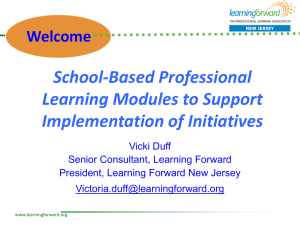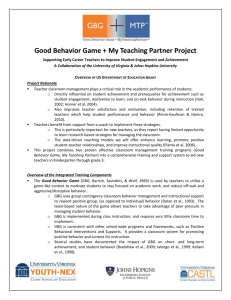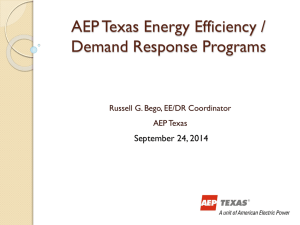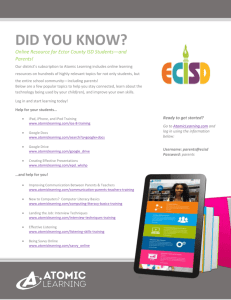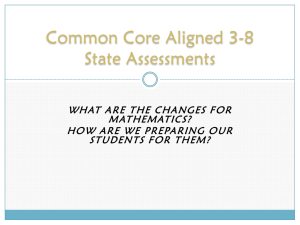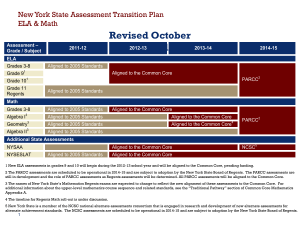Recalibrating Professional Development for
advertisement
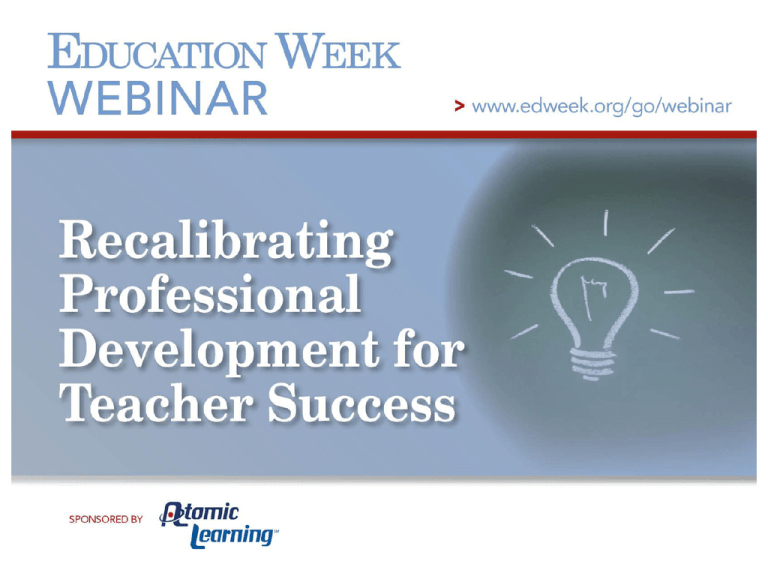
MetLife Foundation provides support for the development of Education Week Teacher and its capacity to engage teachers interactively as a professional community. Anthony Rebora Managing editor of Education Week Teacher and the Teacher Professional Development Sourcebook. www.edweek.org/tm www.teachersourcebook.org Recalibrating Professional Development for Teacher Success Expert Presenters: Joellen Killion is the deputy executive director for Learning Forward, a nonprofit membership association focused on improving professional learning for teachers. She is the author of a number of books and studies on successful teacher professional development models and has extensive experience in professional development planning, design, implementation, and evaluation both at the school and system levels. Robert Pianta is the dean of the Curry School of Education at the University of Virginia and director of the school’s Center for Advanced Study of Teaching and Learning. He has more than 15 years of experience studying student-teacher interactions and, along with a team of researchers, has created detailed professional development frameworks for improving school and classroom experiences. Pianta was featured in a 2008 Malcolm Gladwell New Yorker piece exploring what it takes to identify and develop successful teachers. An on-demand archive of this webinar will be available at www.edweek.org/go/webinar in less than 24hrs. Joellen Killion Deputy Executive Director Learning Forward joellen.killion@learningforward.org 303-432-0958 www.learningforward.org 5 Recalibrating Professional Development for Teacher Success Standards-based Context Process Content Results-based Change in teacher practice Change in student achievement School-based Linked to school improvement goals Linked to districtwide initiatives www.learningforward.org 6 Recalibrating Professional Development for Teacher Success Collective participation Driven by team goals for student achievement Driven by teacher goals for change in practice Content-focused Aligned directly to the specific curriculum teachers are responsible to teach Sustained over time 49 hours associated with 21 percentile point achievement gain Active engagement www.learningforward.org 7 www.learningforward.org Killion, J. (2002). What Works. NSDC. 8 Individually focused Based on individual performance in relationship to performance standards www.learningforward.org 9 School and Team Based Focused on goals for student achievement www.learningforward.org 10 Program Implementation Common Core State Standards Assessment systems Teacher effectiveness measures Response to intervention www.learningforward.org 11 Professional Development in action http://www.learningforw ard.org/standfor/definitio n.cfm www.learningforward.org 12 Recalibrating professional development for teacher success Robert C. Pianta, Ph.D. Dean, Curry School of Education Director, Center for Advanced Study of Teaching and Learning (CASTL) Discover. Create. Change. Issues in teacher performance assessment Accountability moves to teachers Assessment of teacher performance – needs for instruments, properties, decision-making, professional development Stakes aligned with measures: Incentives (merit pay, credit), licensure/certification, sanctions Human Capital Management Systems - organizers Importance of a standardized lens for coherent view of teaching – scalable, reliable, valid Decision-making at various levels Hiring? Tenure? Dismissal? Choices about performance assessment: Observation or only VAM? Known technical properties or unknown? Proven effective or home-grown? Linked to student growth? Aligned with PD or not? Embedded in HCMS? Costs in relation to replacement of existing procedures? Student-teacher interactions and schools Interactions with adults form “infrastructure” for school success: Self-regulation, emotional self-control Task orientation, persistence, motivation Cognitive processes, language Instruction is, in part, a social process: Interactions with teachers are a “medium” Good “instruction” is embedded in relationships and interactions Interactions operate across content Leveraging teachers as game-changers Test-scores cannot produce effective teachers – posting scores, firing teachers won’t fix this. Need to focus on how HCMS drives production of effective teaching. Right now a good teacher is a matter of luck. Measurement and production. Develop valid, effective tools and management systems for districts. Observe teacher behaviors that link to learning – Prove they matter and replicate at scale. Linkages – monitoring/assessment – effective PD -incentives. Right now a lot of slippage and few links Can observational measures be useful? For policy Scalable, reliable, valid, coarse distinctions Reliable, valid, articulated in For program / professional development experience of practitioners Scale Standardization is key Operate consistent across exceptional variation Reality of program / classroom is variation Need for technical support and training infrastructure Web solutions Observation: Technical properties, inferences Detailed manual describing codes/procedures Master-coded video segments/certification Central training of observers live or web Designed for typical day/classroom setup Reliable and Valid (national-level studies, all grades). Technical properties support inferences for hiring, firing, tenure, pay, PD Critical that research evidence supports reliability and validity – defensible decisions Aligned support for high performance Professional development/ training Observational Assessment Resource allocation TeacherStudent Interactions Monitoring/ accountability Transparency Social and academic outcomes for children Improved teacher outcomes Alignment with professional development How observational measures can align with professional development Avoid compliance to meet minimum behavioral standards (e.g., ask three open-ended questions) How to share data — Are scores meaningful to teachers? Key feature of alignment is focus on defined, observable, valid examples of effective teaching as starting point Goal is to produce better teachers Aligned PD: MyTeachingPartner (MTP) Connecting outcomes and inputs - Alignment Classroom Assessment Scoring System (CLASS) – specific definitions of interactions MTP Video Library – analysis of others’ interactions MTP Coaching – ongoing analysis/feedback on own interactions MTP Course – knowledge and analytic skills All tested in RCTs Findings: Effects of MTP support Teachers with MTP coaches Grew more sensitive in interactions with students Increased students’ engagement in instruction Improved language stimulation techniques High-poverty classrooms benefit a great deal Early career teachers benefit from coaching and video Children with MTP teachers Made greater gains in tests of early literacy Experienced lower levels of problem behavior Demonstrated higher levels of expressive language MTP in high school – Gap-closing teachers Same approach – MTP coaching, video library Randomized evaluation study – >100 classrooms 6th-11th grades, all content areas Teachers improved instruction; kids more attentive, engaged Average student with MTP-coached teacher improved 35th-60th percentile on state highstakes standards tests Performance assessment across levels Levels of assessment – state systems, district, school, classroom Consequences and actions – accountability (all levels), capacity development (district/school), professional development (teacher) Data collection, feedback systems, quality improvement resources need to align levels and actions Don’t confuse level of assessment and action Data systems and feedback Systems-level monitoring → District/school-level feedback Aggregate reporting Careful about use for individuals District/school-level assessment → Individual-level feedback Systems monitoring data Higher-density assessments across all sub-units (e.g., classrooms) Linked to PD for individuals, PD plans, incentives Capacity development is a big issue Data systems and feedback Individuals/classrooms Need actionable, aligned feedback Take care if accountability is aim Quality and applicability of assessment/s Implications for P-12 – Experience, results Standardized, valid observations can be scaled and integrated into human capital management and PD Focus measures and PD on teachers’ interactions with children—common language and aligned PD Aligned PD improves interactions and student outcomes – experimental studies Incentives, supports, and targets for teacher behavior/performance in classrooms We can build a better teacher More information: pianta@virginia.edu; www.mtpsecondary.net; www.teachstone.org Want College and Career-Ready Students? Start with the teacher. www.atomiclearning.com Understand Training Gaps Teacher assessment based on ISTE NETS-T Develop Skills 21st Century Skills concept training Blended Professional Development Enhance Curriculum 205 Tech Integration and 21st Century Skills Projects www.atomiclearning.com Reflect & Analyze Progress Individual Progress Reports District-wide Reports for Administrators Provide Support Over 50,000 how-to tutorials on over 205 applications www.atomiclearning.com www.atomiclearning.com An on-demand archive of this webinar will be available at www.edweek.org/go/webinar in less than 24hrs.


